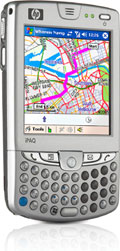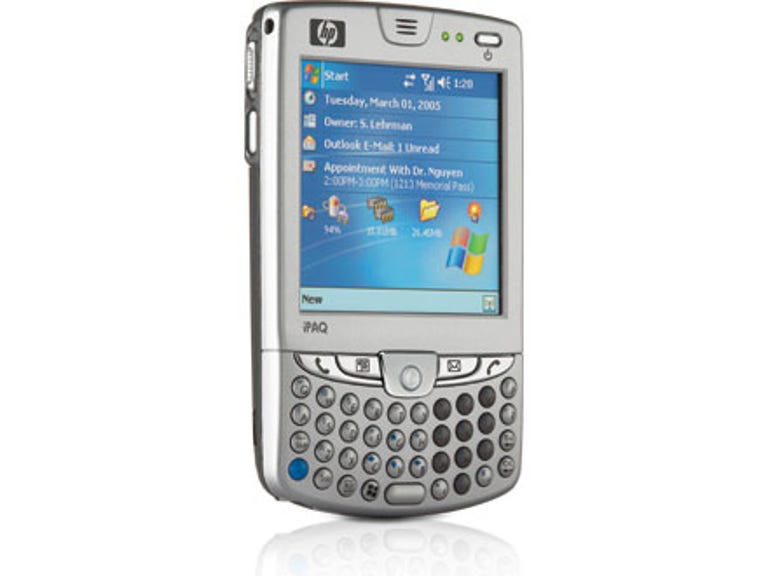 Why You Can Trust CNET
Why You Can Trust CNET HP iPAQ hw6515 review: HP iPAQ hw6515
Can the addition of GPS on HP's latest PDA-phone inject some much-needed oomph back into the dwindelling PDA market?
HP has introduced its second iPAQ PDA-phone to the Australian market at a time when shipments of standalone PDAs are declining and converged devices offering voice and data applications are increasingly being snapped up.
The Good
The Bad
The Bottom Line
HP initially ventured out into the mobile phone market late last year under its iPAQ brand with the introduction of the hw6315. The iPAQ hw6515 is the successor to this model, but alongside some tweaks and additions, we find other features have been nixed.
Design
The hw6315's external stub antenna has thankfully been done away
with and HP has added a QWERTY keyboard to the lower half of the
hw6515, which makes it look similar to the
Palm Treo 650. Alternatively, you can enter text using the
stylus on the iPAQ's 240 x 240-resolution, 65K-colour
touchscreen. The display is protected by a flip-up transparent
plastic visor, which can easily be permanently removed by
unclipping it from the sides of the iPAQ, should the need
arise.
Below the touch-sensitive screen are two user-selectable shortcuts (by default these open your address book and inbox), a mini five-way navigation joystick, call and end keys for phone use.
Flanking the right side of the phone are two card slots -- SD and a smaller miniSD counterpart -- with a 64MB SD card included in the box. On the left is a volume switch and camera shortcut key, while the bottom houses a 2.5mm headphone jack beside the power/cradle port.
Features
For connectivity, quad-band puts the hw6515 into the "world phone
category", allowing it to used be on the four most popular GSM
networks around the globe. Bluetooth makes it easy to transfer
files to your PC and to use a headset for calls, probably a good
idea considering the heft of the iPAQ compared to a regular
mobile phone. A sleek Bluetooth headset like Motorola's Razr
H3 will not only save you from looking like you're talking
into a 118 x 71 x 21mm calculator, but you can keep the 165-gram
device in your pocket rather than propped up on your cheek during
calls.
Surprisingly, for a business-oriented handheld, HP has omitted wireless LAN. While its predecessor had built-in 802.11b, the hw6515 only supports add-on Wi-Fi cards, which retail for around AU$200.
What you do get, though, is Microsoft's long-winded Windows Mobile 2003 Second Edition for Pocket PC (Premium with Phone Edition) operating system, with a 312MHz Intel PXA270 processor and 64MB of both RAM and ROM. Topping it off, HP also includes a built-in 1.3-megapixel camera, complete with night light and a self-portrait assisting mirror.
 |
Aside from regular Pocket PC applications such as calendar, contacts, messaging, tasks and notes, we find Pocket versions of Word, Excel, Internet Explorer, Windows Media Player 10, Jawbreaker and Solitaire. HP's bundled software CD contains ActiveSync, HP Image Transfer, HP iPAQ Quick GPS Connection Utility, BVRP Software's GSM/GPRS Manage and ClearView Office Suite. Accessories include a belt clip, docking station, stereo headset, Whereis Navigator quick start guide, and USB cable.
Performance
While some GPS units use internal memory or expansion cards for
mapping, Whereis Navigator relies on a GPRS data connection. On
top of a monthly subscription charge, users will also have to pay
associated data costs for downloading route information (Sensis
tells us this is minimal). The upside is that the latest maps can
be downloaded, which are updated every six weeks according to
Sensis. Subscription charges for Whereis Navigatior are AU$149
for six months or AU$299 for 12 months.
We thought we'd put the hw6515's GPS navigation to the test over a recent long weekend, taking it along for a 9-hour road trip north from Sydney up to Bellingen. The Whereis software is user friendly and very handy if you have little idea of where you are driving. After entering your starting point and destination, a female British voice regularly updates you on your progress by providing directions through the iPAQ's loudspeaker. For example, you hear something like "in 300m, prepare to turn left" followed by a regular updates on the direction you should be taking. Four separate views on the screen show the next way to turn and distance to the turnoff, your street level position updated in real-time, a higer-level suburb view, or the overall journey in terms of time, streets and direction.
A very handy inclusion of Whereis Navigator is the "Find Around" tool, which gives directions to nearby beaches, cafes, carparks, petrol stations, shops, etc.
To make room for the QWERTY keypad, HP has shrunk the screen size to a rather small 240 x 240 pixels, which manages to squeeze most apps in comfortably, but more scrolling is required for Word and PDF files. Also, the buttons on the hw6515 will be a bit too small for some users, especially when compared to Palm's popular Treo 650.
We found that the average speed of the processor holds the hw6515 back from its full potential. Applications, text entry and the built-in camera feel sluggish, and the limited memory makes multitasking a chore. If integrated GPS is not required, O2's Xda IIi has a 512MHz processor, double the memory and built-in Wi-Fi, for a slightly higher price, but without the thumboard.
The hw6515 is HP's top of the line iPAQ has a recommended retail price of AU$1,199. If you need a PDA that supports wireless, remember to factor in the price of an expansion card. As a relative newcomer to the converged device space, HP faces strong competition alongside the likes of more established smart handheld manufactures, with devices like Nokia's high-end Communicators (9300 and 9500), Blackberry devices such as the 7100v and O2's expanding range of Xdas.
However, patient users looking purely for GPS tracking, contact management, a phone and document manager all-in-one, the HP iPAQ hw6515 fits the bill.


